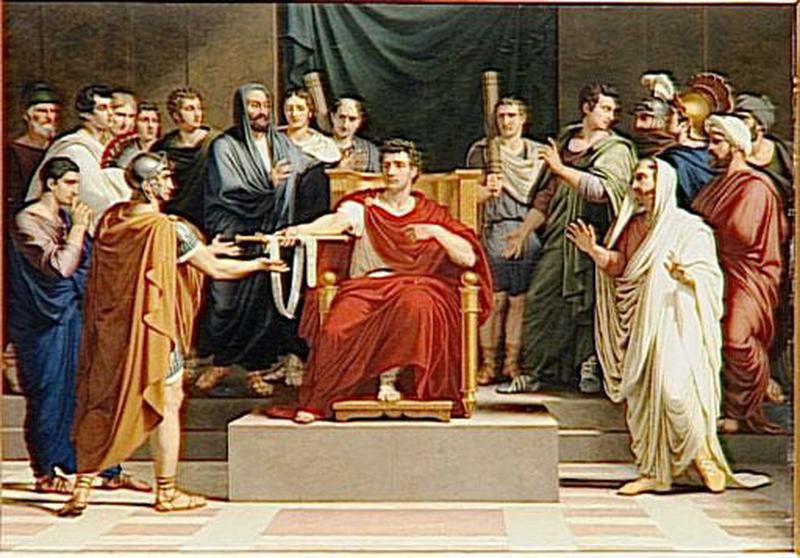Environ 10 résultats pour « Trajan »
-

Trajan
Trajan est un empereur romain né probablement le 18 septembre 53 à Italica en Bétique, mort entre le 7 août 117 et le 9 août 117 à Selinus. Il régna de janvier 98 jusqu'à sa mort. Son règne marque l'apogée territoriale de l'Empire romain. Trajan est le premier empereur romain originaire d'une province et non de Rome même ou de l'Italie; il est considéré traditionnellement par l'historiographie des sénateurs romains comme le meilleur des empereurs. Après le récent règne de Domitien marqué par les persécutions et exécutions de sénateurs romains, et la fin de la dynastie des Flaviens, le court règne de Nerva et surtout celui de Trajan marquent le fondement de la dynastie des Antonins. Avec la conquête de l'Arménie, de la Mésopotamie et surtout de la Dacie, l'empire romain a connu, sous son règne, sa plus grande extension. De plus il étend sa domination sur la plus grande surface territoriale jamais atteinte par l'empire romain. Sur le plan intérieur, Trajan s'attache à renforcer la romanisation des provinces de l'empire.
-

Tête d'homme
-
- Domaine(s) :
- Afrique
- Archéologie
- Égypte antique
-
- Sujet représenté :
- Homme
- Tête humaine
-
- Datation :
- IIe siècle
- Trajan
-
-

-
- Artiste(s) :
- Noël Coypel
TRAJAN DONNANT DES AUDIENCES PUBLIQUES
-
- Sujet représenté :
- Portique (architecture)
- Trajan
-
- Datation :
- XVIIe siècle
-
-

-

-
- Artiste(s) :
- Anonyme
Scènes de la vie de Trajan (verso); Saint Georges terrassan…
-
- Domaine(s) :
- Dessin
-
- Datation :
- XVe siècle
-
-

-
- Artiste(s) :
- Anonyme
Trajan (Légende ne correspondant pas au type figuré : Nerva)
-
- Domaine(s) :
- Émail (verre)
-
- Sujet représenté :
- Couronne (attribut)
- Laurus nobilis
- Palmette
- Portrait
- Trajan
-
- Datation :
- XVIe siècle
-
-

-
- Artiste(s) :
- Noël Coypel
TRAJAN RENDANT LA JUSTICE
-
- Domaine(s) :
- Peinture
-
- Sujet représenté :
- Bienveillance
- Colonne (architecture)
- Femme
- Justice
- Trajan
-
- Datation :
- XVIIe siècle
-
-

-
- Domaine(s) :
- Archéologie
- Gallo-romains
- Numismatique
-
- Désignation :
- dupondius
-
- Datation :
- IIe siècle
-
-

-
- Domaine(s) :
- Archéologie
- Gallo-romains
- Numismatique
-
- Désignation :
- quinaire
-
- Sujet représenté :
- Allégorie
- Couronne (attribut)
- Déesse
- Feuille de palmier
- Laurus nobilis
- Portrait
-
- Datation :
- IIe siècle
- Empire romain
-
-

-
- Domaine(s) :
- Archéologie
- Gallo-romains
- Numismatique
-
- Désignation :
- sesterce
-
- Sujet représenté :
- Fleuve
- Laurus nobilis
- Pont
- Portrait
- Trajan
-
- Datation :
- IIe siècle
- Empire romain
-
-

-
- Domaine(s) :
- Archéologie
- Gallo-romains
- Numismatique
-
- Désignation :
- sesterce
-
- Sujet représenté :
- Laurus nobilis
- Portrait
- Trajan
- Tête humaine
-
- Datation :
- IIe siècle
- Empire romain
-
-

-
- Domaine(s) :
- Archéologie
- Gallo-romains
- Numismatique
-
- Désignation :
- dupondius
-
- Sujet représenté :
- Allégorie
- Couronne (attribut)
- Déesse
- Laurus nobilis
- Portrait
- Trajan
- …
-
- Datation :
- IIe siècle
- Empire romain
-
-

Sesterce de Trajan (98-117)
-
- Domaine(s) :
- Archéologie
- Gallo-romains
- Numismatique
-
- Sujet représenté :
- Empereur
- Trajan
- Tête humaine
-
- Datation :
- IIe siècle
- Gaule romaine
-
-

-
- Artiste(s) :
- Pierre Didot
Planches de l'iconographie romaine (pl 36) : Empereurs, Cés…
-
- Domaine(s) :
- Archéologie
- Estampe
- Numismatique
- Rome antique
-
- Sujet représenté :
- Empereur romain
- Homme
- Monnaie
- Nerva
- Portrait
- Rome antique
-
- Datation :
- XIXe siècle
-
